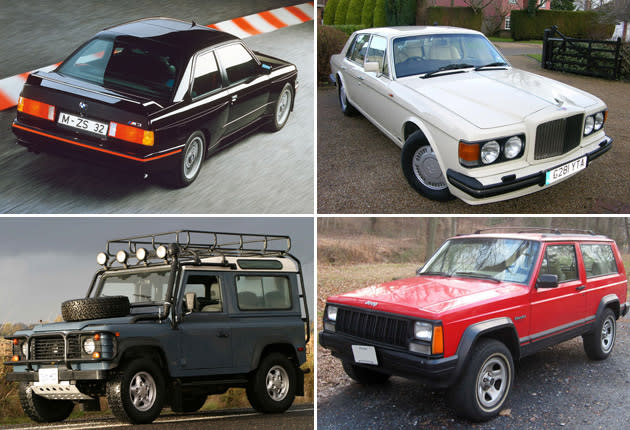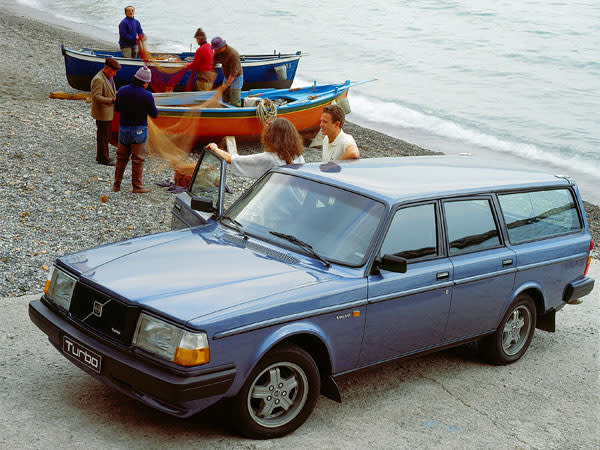The box rocks: 10 cars hip to be square

MORE AT POPULAR MECHANICS
Decades before the Scion xB or Nissan Cube were making boxy cars cool for the new millennium, the roads were packed to the guardrails with square-shouldered machines. Some cars were boxy for practical reasons. Others did it for style—it was hip to be square in the '70s and '80s.

Volvo 240 (1975–1993)
If there was a car that defined boxy but beautiful, it would have to be the Volvo. These machines were so square that the later higher-powered versions became known as turbo bricks. These 240 turbo models were quick, hitting 60 mph in less than 8 seconds—not bad for 1985. But all 240s are known for exemplary reliability, safety, and roominess. The trunks are incredibly large for such a diminutive car, a fact that's especially true for the wagons, which could swallow 71 cubic feet of stuff with the rear seat down. Hey, right angles are perfect for fitting lots of gear. And don't forget: Volvo 240s were rated to tow 3300 pounds. A modern Jeep Wrangler needs a "tow package" to handle as much.

BMW M3 (1988–1991)
The E30 BMW, otherwise known as the generation of 3-Series that ran from 1984 to 1991 was an icon for the '80s and a design blueprint for other manufacturers. The E30's crisply cut lines became all the more alluring when BMW flared its fenders wide for use on the first M3. The E30 generation M3 was the company's first modern and (relatively) affordable ultra-performance machine.
The M3 produced nearly 200 hp from a nonturbocharged four-cylinder engine. That's impressive even today, but we're talking about the late 1980s, when Chevy's mighty 5.7-liter V-8-powered Corvette made just 240 hp. Beyond slaying more exotic machinery on public roads, the chiseled Bavarian's main purpose was to beat rival German sports sedans on the racetrack. (After all, the M is for Motorsport). BMW made just fewer than 5000 of these M3s, but they cemented the brand's identity as "the Ultimate Driving Machine."

Mercedes-Benz 500E (1991–1994)
The W124 series Mercedes-Benz E-Class (1984–1995) was the most angular, square-jawed, and attractive of the 1980s Bruno Sacco–designed Benzes. It was arguably one of the best built and most durable car platforms the company had ever produced, too. The most potent W124 came at the end of the run, in the early 1990s.
Today Mercedes has AMG as its in-house tuning shop building high-performance Benzes. But back in the early 1990s, AMG was just a rogue tuning shop. When Mercedes decided to build its first high-performance sedan to compete with BMW's M5, it chose Porsche. The 500E (known as the E500 for 1994) was largely hand-assembled and shuttled back and forth between the two automakers' factories in Germany. It packed a 322-hp V-8 pulled from the 500 SL and could crush 60 mph in just 5.5 seconds, making it one of the quickest sedans of the day.

Jeep Cherokee (1984–2001)
In the early 1980s, manufacturers realized they needed smaller and more fuel-efficient trucks to sell to young families. Jeep designed its new XJ Cherokee with lightweight unit-body construction (in which frame and body are one unit, like most cars), but retained its solid axle suspension for tremendous off-road capability. Better still, the Cherokee didn't wear smooth, rounded sheet metal like some small SUVs. This was a Jeep, after all, So XJs looked angular and tough.
The popular XJ was just as capable in the dirt as it was on a twisty slab of blacktop—the perfect blend of both sport and utility. The Cherokee was innovative, too, because while most competitors offered only two-door models, the XJ came with two or four doors. It was so beloved that Jeep kept the rig in production for 17 years.

 Yahoo Autos
Yahoo Autos 
